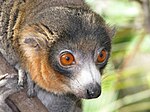Lemurs are an infraorder of strepsirrhine primates that is endemic to the island of Madagascar. Although lemurs often are confused with ancestral primates, the anthropoid primates (monkeys, apes, and humans) did not evolve from them; instead, lemurs merely share morphological and behavioral traits with basal primates. Lemurs arrived in Madagascar approximately 62 to 65 mya by rafting on mats of vegetation at a time when ocean currents favored oceanic dispersal to the island. Since that time, lemurs have evolved to cope with an extremely seasonal environment and their adaptations give them a level of diversity that rivals that of all other primate groups. Until shortly after humans arrived on the island approximately 2,000 years ago, there were lemurs as large as a male gorilla. These subfossil lemurs were all larger than species living currently. Today, there are nearly 100 species of lemurs, and most of those species were discovered or promoted to full species status since the 1990s; however, lemur taxonomic classification is controversial and depends on which species concept is used. Living lemurs range in size from 30 g (1.1 oz) to 9 kg (20 lb). Lemurs share many common, basal primate traits, such as divergent digits on their hands and feet and nails instead of claws (in most species). However, their brain-to-body size ratio is smaller than that of anthropoid primates, and among many other traits they share with other strepsirrhine primates, they have a "wet nose" (rhinarium).
